

Building a Renaissance Lute
 The 5-course lute of the Middle Ages gained a sixth course in the Renaissance. By 1575 it more often had 7-courses. By the end of the 16th century, an eighth course had been added. The first decades of the 17th century saw lutes with up to 10 courses. The lower bass courses sounded dull, so an octave string was added to brighten up the sound. Wound strings wouldn't be invented until about 1660 and were disliked by musicians because of the abrupt change in tone quality between the plain gut strings and the wire-wound strings. Twisted gut basses with plain gut octaves have a quicker decay than wound strings, which contributed to the clear texture of polyphonic music. I built this lute for all-gut strings. This will allow me to explore the balance of tone colors, harmonics, and voice-leading of the music as it was heard by the lutenists of old.
The 5-course lute of the Middle Ages gained a sixth course in the Renaissance. By 1575 it more often had 7-courses. By the end of the 16th century, an eighth course had been added. The first decades of the 17th century saw lutes with up to 10 courses. The lower bass courses sounded dull, so an octave string was added to brighten up the sound. Wound strings wouldn't be invented until about 1660 and were disliked by musicians because of the abrupt change in tone quality between the plain gut strings and the wire-wound strings. Twisted gut basses with plain gut octaves have a quicker decay than wound strings, which contributed to the clear texture of polyphonic music. I built this lute for all-gut strings. This will allow me to explore the balance of tone colors, harmonics, and voice-leading of the music as it was heard by the lutenists of old.
This picture, Duet, by Hendrick Ter Brugghen, 1628, showns a ten course lute with raised chanterelle on the pegbox (for the top string).
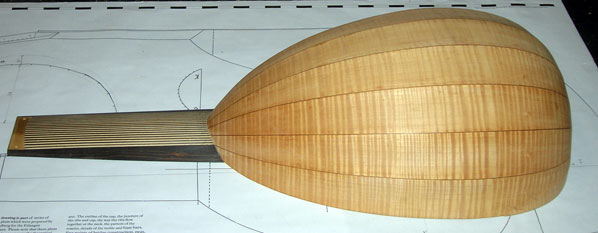 The body of this lute was built from figured maple that had been in my workshop for more than 30 years. It has taken on a beautiful golden color. Each of the maple ribs is separated by a rosewood fillet.
The body of this lute was built from figured maple that had been in my workshop for more than 30 years. It has taken on a beautiful golden color. Each of the maple ribs is separated by a rosewood fillet.
 The neck was built from poplar and veneered with ebony. Alternating strips of ebony and white holy create the ebony/ivory effect seen on old lutes.
The neck was built from poplar and veneered with ebony. Alternating strips of ebony and white holy create the ebony/ivory effect seen on old lutes.
 |
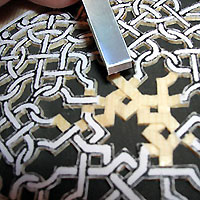 |
 |
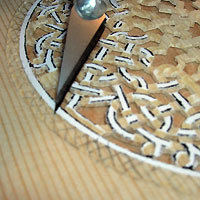 |
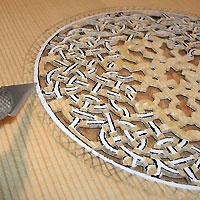 |
 |
Steps in carving the "Knot of Leonardo" | ||
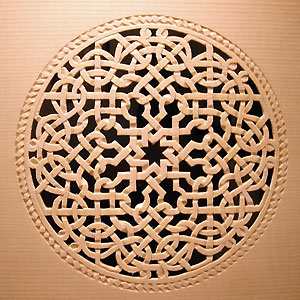
The finished rosette.
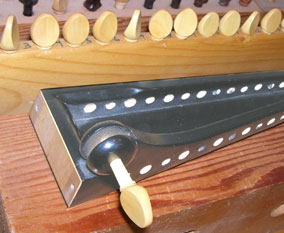

The pegbox is cut from maple and dyed black with India ink to match the neck. The raised treble peg is a feature seen in old paintings, like the one above. The pegs were turned from boxwood. I glued a wedge of spruce onto the top of the neck and shaped it into a gentle curve. When I glue the ebony fingerboard on top of the neck, it will have enough camber to help hold the frets tight and to make bar chords a little easier.